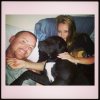Here are tips/suggestions to help you with Kane since he's your first rescue.
The following tips/suggestions are based on my experience (I rescued my pup in Feb. 2012 and volunteered at an animal shelter for a year) and forum posts from other members. Basically, I*m lazy and didn*t want to continue retyping the following tips/suggestions.
*First, I*d like to say it generally takes a re-homed pup 8-12 months to fully accept and trust their new family.
*The new pup will be stressed due to the environmental change and they may not eat or socialize much. Most will sit in their crate in the corner because they are stressed. Do not force the pup to eat or come out of the crate. The pup will let you know when they are ready. It helps the new pup for you to sit by the crate and talk to them and give them high value treats, i.e. such as cooked chicken, hamburger or hot dogs. They may or may not eat the treats.
A rescue requires TONS of patience, consistency in training and LOTS of love.
*BONDING WITH NEW PUP
The family will need to bond with the new pup. Bonding can be established by walking the pup, brushing the pup, hand feeding the pup, training the pup and good old cuddling with the pup.
*HISTORY OF THE NEW PUP
Many times when you rescue a pup, you do not know their history. Generally, the pup is at the rescue or shelter because of owner surrender. Many times, mastiffs are surrendered because the previous owner didn*t know they would get as big as they do, they are messy because of their drool, or they no longer have time for the pup. Regardless of the reason, you generally do not know the pup*s history.
*INTRODUCING NEW PUP TO OTHER FAMILY PUPS
Generally, if you plan to rescue a pup, let the current pup(s) meet the new pup before signing on the dotted line to rescue the pup. I have seen many pups returned to the shelter/rescue because the current pup did not accept them.L
If you have other pups, then you need to introduce the pups on neutral ground at least a couple of times before bringing the new pup home.
*CRATE FOR THE NEW PUP
It is highly recommended to crate the new pup. Look at it as if it is their own little room where they can go to decompress when stressed. Do not use the crate as a punishment tool. Place a blanket, towel, pillow, and/or stuffed animal in the crate. Be aware that some pups do not like items in the crate with them but if they do, it will help the pup to relax.
*POTTY TRAINING
The pup may have to be re-trained to potty outside especially if they have lived in a cage at the shelter/rescue. If the pup has been in the shelter for more than a couple of days, they have learned to potty on the concrete in the cage.
*FOOD
Find out what kind of food the shelter/rescue/breeder was feeding the pup and continue to feed it to the pup until you transition to a newer food because most shelters/rescues/breeders use the cheapest food, meaning it is not very good for the pup.
Slow transition to the new food is as follows to prevent diarrhea. If at any time during the transition, the pup has diarrhea return to previous amounts of food per feeding. If you are switching flavors made by the same manufacturer, you should not have to do a slow transition.
Amount per feeding:
Day 1-4 ¾ cup of old food and ¼ cup of new food.
Day 5-9 ½ cup of old food and ½ cup of new food.
Day 10-14 ¾ cup of new food and ¼ cup of old food
Day 15 Start 100% of new food
Generally, mastiffs are allergic to grain and chicken found in kibble. You can check
www.dogfoodadvisor.com for dog food ratings and customer feedback. Mastiff puppies should eat Large Breed puppy food and they can continue to eat the food all of their lives or you can switch them to a Large Breed Adult Food at about 8-10 months.
Check out Acana Regionals, Wellness Core, Earthborn Holistics, Fromm*s or Taste of the Wild. Chewy.com is a great place to order dog food.
You may want to check out the raw diet for your pup. Check out the sub forum on raw diet that has a wealth of information. It is not recommended to feed the pup kibble (one with grains) and raw food. Dr. Becker talks about this in one of her videos. Search Dr. Becker*s videos on youtube.com for a lot of great information regarding the raw diet. There are 3 parts to the series. Well worth the time to watch the videos.
*PUP NOT EATING WHEN YOU FIRST BRING THEM HOME
They not used to their new environment and this is a natural behavior. Take the pup to a quiet place at meal times and sit and hand feed the pup. This will help the pup to eat when they are placed in a calm atmosphere and it helps you to bond with the pup and helps the pup to establish trust with you. As they become settled, they will naturally follow your routine.
*TRAINING
Start basic commands and reward with motivational treats (fav food or fav toy). For an older pup, train for about 10 minutes a day to start and increase training time as the pup starts to trust you more. For a younger pup, train for about 5 minutes a day to start. Once they master one command, move onto another command.
Number one command is sit. Teach the pup to sit, by placing a treat in front of his head and move it to the back causing him to sit to get the treat. When the pup sits, tell them good sit and give them the treat.
Second command should be "focus/look" This will help you tremendously when the pup is over 100 lbs. Put the pup into sit. With a treat in your hand (let the pup smell it), put the treat up to your eyes and tell the pup to look or focus. They may only do this for about 1-2 seconds. As soon as they look at your eyes, reward them. Generally, mastiffs do not like to look anyone in the eyes for long because that means a challenge to them.
Other commands are "down/off", "leave it," "wait" (short pause), "stay" (pausing until you release), drop it and "quiet/calm".
When you are training and when the pup does not do as you ask, then tell him no in a calm, stern voice and redirect back to the command. The only time a stern and loud NO should be used is when they are doing something that can cause harm to themselves or others.
Praise is the most powerful tool you have and the dog WANTS to please you. Show them clearly what you want, notice and praise when they comply, and learning goes much faster and pleasant for you both.
Mastiffs can be extremely stubborn and if you get frustrated with them, they will shut down and stop listening to you. Mastiffs do not do well with yelling or hitting. Hitting can result in some unwanted mastiff behavior meaning fear aggression, which equals biting.
*SOCIALIZE, SOCIALIZE AND SOCIALIZE SOME MORE
Do not take your pup to dog parks until you have learned his body language. Know when he is getting stressed or excited around humans or other pups. Walk your pup at a regular park on leash to learn his body language.
*EXERCISE
Structured exercise/play on hard surfaces and where they don't have they ability to pace themselves is where you need to be very careful. This type of exercise could harm the pup*s joints and bones. Puppies should not do any excessive exercise, i.e. walking, jumping, running and navigate stairs for the first 12 months to avoid injury.
Stairs should be maneuvered while on leash (even in the house) especially going down the stairs. Stairs should have carpet or rubber matting to give the pup traction. Mastiffs should be assisted up and down stairs until they are about age 12 months to prevent injury.
Most mastiffs can be very lazy but they still need to exercise. Generally, the amount of time to exercise is 5 minutes per each month of age.
*CHILDREN IN THE HOME
Until you know how the new pup will react to the children, leave them on leash while in the house. Teach your children to bond with the new pup by hand feeding the pup, brushing the pup, walking the pup in the house or your own yard and training the pup.
**DO NOT allow the children to get on the floor to play with the pup.
**DO NOT allow the children to play around the pup while the pup is eating their food or high value treat or their favorite toy.
The new pup may have resource guarding due to their life in a shelter or rescue.
If the pup has resource guarding, here*s a great article:
http://www.aspca.org/pet-care/virtual-pet-behaviorist/dog-behavior/food-guarding
This type of behavior can take up to 4-6 months to correct and requires a lot of patience and consistency. During this time, DO NOT ALLOW children or other pups around the new pup while they are eating or enjoying a treat/toy.
*DE-SEXING YOUR DOG
Health Issues Linked to Spaying and Neutering Dogs
Enjoy your new family member~






